Predictive Assessment of Forest Fire Risk in the Hindu Kush Himalaya (HKH) Region Using HIWAT Data Integration
Abstract
1. Introduction
2. Materials and Methods
2.1. Study Area
2.2. Data Acquisition and Processing
2.2.1. High-Impact Weather Assessment Toolkit (HIWAT) Data
2.2.2. MODIS & VIIRS Data
2.2.3. Field Data
- Date and location of the incident;
- Estimated area burned;
- Type and extent of damage to forest resources and infrastructure;
- Reported casualties or fatalities (if any).
2.3. Fire Weather Index Calculation
- Fine Fuel Moisture Code (FFMC): Surface litter flammability;
- Duff Moisture Code (DMC): Moisture content in decomposing organic layers;
- Drought Code (DC): Deep duff and organic soil dryness;
- Initial Spread Index (ISI): Potential fire spread rate based on wind and surface dryness;
- Buildup Index (BUI): Total available fuel calculated from DMC and DC;
- Fire Weather Index (FWI): A composite index representing potential fire intensity.
2.3.1. Validation of the HIWAT-Driven FWI System
2.3.2. Automated Processing Workflow and Dissemination
3. Results
3.1. Long-Term Spatiotemporal Trends in Forest Fire Activity (2001–2024)
3.2. Spatiotemporal Distribution of Active Fires by Land Cover Type in Nepal (2001–2024)
3.3. Burn Area
3.4. Fire Weather
3.4.1. Fine Fuel Moisture Code (FFMC)
3.4.2. Initial Spread Index (ISI)
3.4.3. Buildup Index (BUI)
3.4.4. Fire Weather Index (FWI)
3.5. Validation
4. Discussion
5. Conclusions
Author Contributions
Funding
Data Availability Statement
Conflicts of Interest
References
- Jones, M.W.; Veraverbeke, S.; Andela, N.; Doerr, S.H.; Kolden, C.; Mataveli, G.; Pettinari, M.L.; Le Quéré, C.; Rosan, T.M.; van der Werf, G.R.; et al. Global rise in forest fire emissions linked to climate change in the extratropics. Science 2024, 386, eadl5889. [Google Scholar] [CrossRef] [PubMed]
- Abatzoglou, J.T.; Williams, A.P. Impact of anthropogenic climate change on wildfire across western US forests. Proc. Natl. Acad. Sci. USA 2016, 113, 11770–11775. [Google Scholar] [CrossRef] [PubMed]
- Flannigan, M.D.; Krawchuk, M.A.; de Groot, W.J.; Wotton, B.M.; Gowman, L.M. Implications of changing climate for global wildland fire. Int. J. Wildland Fire 2009, 18, 483–507. [Google Scholar] [CrossRef]
- Bowman, D.M.J.S.; Balch, J.K.; Artaxo, P.; Bond, W.J.; Carlson, J.M.; Cochrane, M.A.; D’Antonio, C.M.; DeFries, R.S.; Doyle, J.C.; Harrison, S.P.; et al. Fire in the Earth System. Science 2009, 324, 481–484. [Google Scholar] [CrossRef]
- Chaudhary, S.; Nepal, S.; Hussain, A.; Bhuchar, S. Safeguarding the third pole: Problems, challenges, and possible solutions in the Hindu Kush Himalaya. In Safeguarding Mountain Social-Ecological Systems; Elsevier: Amsterdam, The Netherlands, 2024; Volume 2, pp. 271–280. [Google Scholar]
- ICIMOD. Water, Ice, Society, and Ecosystems in the Hindu Kush Himalaya: An Outlook; Wester, P., Chaudhary, S., Chettri, N., Jackson, M., Maharjan, A., Nepal, S., Steiner, J.F., Eds.; ICIMOD: Lalitpur, Nepal, 2023. [Google Scholar] [CrossRef]
- Wester, P.; Rathore, B.M.S.; Vasily, L.A.; Sharma, E.; Molden, D. The Hindu Kush Himalaya Call to Action: Sustaining Mountain Environments and Improving Livelihoods. Mt. Res. Dev. 2020, 40, P1–P4. [Google Scholar] [CrossRef]
- Acharya, G.; Shrestha, S.; Poudel, S.; Paudel, S.R. Climate change challenges to meeting the sustainable development goals in the Hindu Kush Himalayan region. Int. J. Environ. Stud. 2024, 81, 531–536. [Google Scholar] [CrossRef]
- Wester, P.; Mishra, A.; Mukherji, A.; Shrestha, A.B. The Hindu Kush Himalaya Assessment: Mountains, Climate Change, Sustainability and People; Springer Nature: Berlin/Heidelberg, Germany, 2019; p. 627. [Google Scholar]
- Wang, S.W.; Lim, C.-H.; Lee, W.-K. A review of forest fire and policy response for resilient adaptation under changing climate in the Eastern Himalayan region. For. Sci. Technol. 2021, 17, 180–188. [Google Scholar] [CrossRef]
- Thapa, S.; Chitale, V.S.; Pradhan, S.; Shakya, B.; Sharma, S.; Regmi, S.; Bajracharya, S.; Adhikari, S.; Dangol, G.S. Forest Fire Detection and Monitoring. In Earth Observation Science and Applications for Risk Reduction and Enhanced Resilience in Hindu Kush Himalaya Region; Bajracharya, B., Thapa, R.B., Matin, M.A., Eds.; Springer: Cham, Switzerland, 2021. [Google Scholar] [CrossRef]
- Xu, J.; Grumbine, R.E.; Shrestha, A.; Eriksson, M.; Yang, X.; Wang, Y.; Wilkes, A. The melting Himalayas: Cascading effects of climate change on water, biodiversity, and livelihoods. Conserv. Biol. 2009, 23, 520–530. [Google Scholar] [CrossRef]
- Bhattarai, N.; Dahal, S.; Thapa, S.; Pradhananga, S.; Karky, B.S.; Rawat, R.S.; Windhorst, K.; Watanabe, T.; Thapa, R.B.; Avtar, R. Forest Fire in the Hindu Kush Himalayas: A Major Challenge for Climate Action. J. For. Livelihood 2022, 21, 14–31. [Google Scholar] [CrossRef]
- Mishra, B.; Panthi, S.; Poudel, S.; Ghimire, B.R. Forest fire pattern and vulnerability mapping using deep learning in Nepal. Fire Ecol. 2023, 19, 3. [Google Scholar] [CrossRef]
- Adhikari, G.; Joshi, K.P.; Chad, D.; Ghimire, A.; Mahara, S. Spatial Dynamics and Risk Mapping of Forest Fires in Madhesh Province, Nepal: A Multi-Criteria Decision Approach. Environ. Nat. Resour. J. 2025, 23, 80–94. [Google Scholar] [CrossRef]
- Joshi, G.R.; Rijal, K.; Bhandari, R.; Sapkota, R.P.; Dhital, N.B. A Review of Implementation of Policy Instruments on Forests Fire in Nepal. J. For. Environ. Sci. 2024, 40, 167–179. [Google Scholar]
- Paudel, G.; Pandey, K.; Lamsal, P.; Bhattarai, A.; Bhattarai, A.; Tripathi, S. Geospatial forest fire risk assessment and zoning by integrating MaxEnt in Gorkha District, Nepal. Heliyon 2024, 10, e31305. [Google Scholar] [CrossRef] [PubMed]
- Department of Forest Research and Survey (DFRS). Annual Forest Fire Report 2023; Ministry of Forests and Environment: Kathmandu, Nepal, 2023.
- FRTC. National Land Cover Monitoring System of Nepal, 2020–2022; Forest Research and Training Centre (FRTC): Kathmandu, Nepal, 2024.
- Parajuli, A.; Gautam, A.P.; Sharma, S.; Lamichhane, P.; Sharma, G.; Bist, B.S.; Aryal, U.; Basnet, R. A Strategy for involving community forest managers in effective forest fire management in Nepal. Banko Janakari 2022, 32, 41–51. [Google Scholar] [CrossRef]
- Chuvieco, E.; Mouillot, F.; van der Werf, G.R.; San Miguel, J.; Tanase, M.; Koutsias, N.; García, M.; Yebra, M.; Padilla, M.; Gitas, I.; et al. Historical background and current developments for mapping burned area from satellite Earth observation. Remote Sens. Environ. 2019, 225, 45–64. [Google Scholar] [CrossRef]
- Giglio, L.; Schroeder, W.; Justice, C.O. The collection 6 MODIS active fire detection algorithm and fire products. Remote Sens. Environ. 2016, 178, 31–41. [Google Scholar] [CrossRef]
- Justice, C.O.; Giglio, L.; Korontzi, S.; Owens, J.; Morisette, J.T.; Roy, D.; Descloitres, J.; Alleaume, S.; Petitcolin, F.; Kaufman, Y. The MODIS fire products. Remote Sens. Environ. 2002, 83, 244–262. [Google Scholar] [CrossRef]
- AFDRS, Australian Fire Danger Rating System. (n.d.). Australian Fire Danger Rating System. Available online: https://afdrs.com.au/ (accessed on 17 May 2025).
- Zacharakis, I.; Tsihrintzis, V.A. Environmental forest fire danger rating systems and indices around the globe: A review. Land 2023, 12, 194. [Google Scholar] [CrossRef]
- Stocks, B.J.; Lynham, T.J.; Lawson, B.D.; Alexander, M.E.; Van Wagner, C.E.; McAlpine, R.S.; Dubé, D.E. Canadian Forest Fire Danger Rating System: An Overview. For. Chron. 1989, 65, 258–265. [Google Scholar] [CrossRef]
- Van Wagner, C.; Forest, P. Development and structure of the canadian forest fireweather index system. In Forestry Technical Report—Canadian Forestry Service; Petawawa National Forestry Institute: Chalk River, ON, Canada, 1987. [Google Scholar]
- Deeming, J.E. National Fire-Danger Rating System; Rocky Mountain Forest and Range Experiment Station, Forest Service, US Department of Agriculture: Washington, DC, USA, 1972; Volume 84.
- Noble, I.R.; Bary, G.A.V.; Gill, A.M. McArthur’s fire-danger meters expressed as equations. Aust. J. Ecol. 1980, 5, 201–203. [Google Scholar] [CrossRef]
- McArthur, A.G. Fire Behaviour in Eucalypt Forests; Commonwealth of Australia Forestry and Timber Bureau: Canberra, Australia, 1967. [Google Scholar]
- Vitolo, C.; Di Giuseppe, F.; Krzeminski, B.; San-Miguel-Ayanz, J. A 1980–2018 global fire danger re-analysis dataset for the Canadian Fire Weather Indices. Sci. Data 2019, 6, 190032. [Google Scholar] [CrossRef]
- De Jong, M.C.; Wooster, M.J.; Kitchen, K.; Manley, C.; Gazzard, R.; McCall, F.F. Calibration and evaluation of the Canadian Forest Fire Weather Index (FWI) System for improved wildland fire danger rating in the United Kingdom. Nat. Hazards Earth Syst. Sci. 2016, 16, 1217–1237. [Google Scholar] [CrossRef]
- ICIMOD. The HKH Call to Action: Building Resilience for Mountains and People; International Centre for Integrated Mountain Development: Kathmandu, Nepal, 2020. [Google Scholar]
- Golding, B. Towards the “Perfect” Weather Warning: Bridging Disciplinary Gaps Through Partnership and Communication; Springer Nature: Berlin/Heidelberg, Germany, 2022; p. 270. [Google Scholar]
- Case, J.; Mayer, T. High-Impact Weather Assessment Toolkit (HIWAT). In NASA Global Hydrometeorology Resource Center Distributed Active Archive Center (DAAC) Data Set; DATA101: Huntsville, AL, USA, 2023. [Google Scholar]
- Giglio, L.; Descloitres, J.; Justice, C.O.; Kaufman, Y.J. An enhanced contextual fire detection algorithm for MODIS. Remote Sens. Environ. 2003, 87, 273–282. [Google Scholar] [CrossRef]
- Schroeder, W.; Oliva, P.; Giglio, L.; Csiszar, I.A. The New VIIRS 375 m active fire detection data product: Algorithm description and initial assessment. Remote Sens. Environ. 2014, 143, 85–96. [Google Scholar] [CrossRef]
- Csiszar, I.; Schroeder, W.; Giglio, L.; Ellicott, E.; Vadrevu, K.P.; Justice, C.O.; Wind, B. Active Fires from the Suomi NPP Visible Infrared Imaging Radiometer Suite: Product Status and First Evaluation Results. J. Geophys. Res. Atmos. 2014, 119, 803–816. [Google Scholar] [CrossRef]
- Giglio, L.; Boschetti, L.; Roy, D.P.; Humber, M.L.; Justice, C.O. The Collection 6 MODIS burned area mapping algorithm and product. Remote Sens. Environ. 2018, 217, 72–85. [Google Scholar] [CrossRef]
- Wang, Y.; Anderson, K.R.; Suddaby, R.M. Updated Source Code for Calculating Fire Danger Indices in the Canadian Forest Fire Weather Index System; Natural Resources Canada, Canadian Forest Service: Edmonton, AB, Canada, 2015. [Google Scholar]
- Wotton, B.M. Interpreting and using outputs from the Canadian Forest Fire Danger Rating System in research applications. Environ. Ecol. Stat. 2009, 16, 107–131. [Google Scholar] [CrossRef]
- Nicoletti, G.; Saravia, L.; Momo, F.; Maritan, A.; Suweis, S. The emergence of scale-free fires in Australia. iScience 2023, 26, 106181. [Google Scholar] [CrossRef]
- Rodrigues, M.; Zúñiga-Antón, M.; Alcasena, F.; Gelabert, P.; Vega-Garcia, C. Integrating geospatial wildfire models to delineate landscape management zones and inform decision-making in Mediterranean areas. Saf. Sci. 2022, 147, 105616. [Google Scholar] [CrossRef]
- Masson-Delmotte, V.; Zhai, P.; Pirani, A.; Connors, S.L.; Péan, C.; Berger, S.; Goldfarb, L.; Gomis, M.I.; Matthews, J.B.R.; Berger, S.; et al. Climate change 2021: The physical science basis. In Contribution of Working Group I to the Sixth Assessment Report of the Intergovernmental Panel on Climate Change; IPCC: Geneva, Switzerland, 2021; Volume 2, p. 2391. [Google Scholar]
- Bhujel, K.B.; Sapkota, R.P.; Khadka, U.R. Temporal and Spatial Distribution of Forest Fires and their Environmental and Socio-economic Implications in Nepal. J. For. Livelihood 2022, 21, 1–13. [Google Scholar] [CrossRef]
- Laudari, H.K.; Aryal, K.; Maraseni, T.; Pariyar, S.; Pant, B.; Bhattarai, S.; Kaini, T.R.; Karki, G.; Marahattha, A. Sixty-five years of forest restoration in Nepal: Lessons learned and way forward. Land Use Policy 2022, 115, 106033. [Google Scholar] [CrossRef]
- Rusk, J.; Maharjan, A.; Tiwari, P.; Chen, T.-H.K.; Shneiderman, S.; Turin, M.; Seto, K.C. Multi-hazard susceptibility and exposure assessment of the Hindu Kush Himalaya. Sci. Total Environ. 2022, 804, 150039. [Google Scholar] [CrossRef] [PubMed]
- Dupuy, J.-L.; Fargeon, H.; Martin-StPaul, N.; Pimont, F.; Ruffault, J.; Guijarro, M.; Hernando, C.; Madrigal, J.; Fernandes, P. Climate change impact on future wildfire danger and activity in southern Europe: A review. Ann. For. Sci. 2020, 77, 35. [Google Scholar] [CrossRef]
- Uddin, K.; Matin, M.A.; Khanal, N.; Maharjan, S.; Bajracharya, B.; Tenneson, K.; Poortinga, A.; Quyen, N.H.; Aryal, R.R.; Saah, D.; et al. Regional land cover monitoring system for Hindu Kush Himalaya. In Earth Observation Science and Applications for Risk Reduction and Enhanced Resilience in Hindu Kush Himalaya Region: A Decade of Experience from SERVIR; Springer: Cham, Switzerland, 2021; pp. 103–125. [Google Scholar]
- Shrestha, A.B.; Bajracharya, S.R.; Sharma, A.R.; Khanal, N.R. Climate change and disaster impacts in the Hindu Kush Himalaya. Int. J. Environ. Res. Public Health 2018, 15, 2583. [Google Scholar]
- Matin, M.A.; Chitale, V.S.; Murthy, M.S.R.; Uddin, K.; Bajracharya, B.; Pradhan, S. Understanding forest fire patterns and risk in Nepal using remote sensing, geographic information system and historical fire data. Int. J. Wildland Fire 2017, 26, 276–286. [Google Scholar] [CrossRef]
- Sapkota, S.; Joshi, K.P.P.; Kuikel, S.; Kuinkel, D.; Bhandari, B.; Wu, Y.; Bing, H.; Marahatta, S.; Aryal, D.; Wang, S.-Y.S.; et al. Advancing wildfire prediction in Nepal using machine learning algorithms. Environ. Res. Commun. 2025, 7, 055003. [Google Scholar] [CrossRef]
- Bar, S.; Parida, B.R.; Pandey, A.C.; Kumar, N. Pixel-Based Long-Term (2001–2020) Estimations of Forest Fire Emissions over the Himalaya. Remote Sens. 2022, 14, 5302. [Google Scholar] [CrossRef]
- Maraseni, T.N.; Reardon-Smith, K.; Griffiths, G.; Apan, A. Savanna burning methodology for fire management and emissions reduction: A critical review of influencing factors. Carbon Balance Manag. 2016, 11, 25. [Google Scholar] [CrossRef]
- Sharma, S.; Pokhrel, A. Challenges in forest fire management in the Himalaya: Experiences from Nepal. Trop. For. 2022, 61, 137–143. [Google Scholar] [CrossRef]
- Shrestha, S.; Regmi, S.; Shrestha, S.; Sanyal, S.; Thapa, N.; Dulal, B. Forest Fires in Nepal: The Unseen Threat of Droughts. ICIMOD Blog. Available online: https://blog.icimod.org/cryosphere-water-risks/forest-fires-in-nepal-the-unseen-threat-of-droughts/ (accessed on 31 March 2025).
- Pandey, H.P.; Pokhrel, N.P.; Thapa, P.; Paudel, N.S.; Maraseni, T.N. Status and practical implications of forest fire management in Nepal. J. For. Livelihood 2022, 21, 32–45. [Google Scholar] [CrossRef]
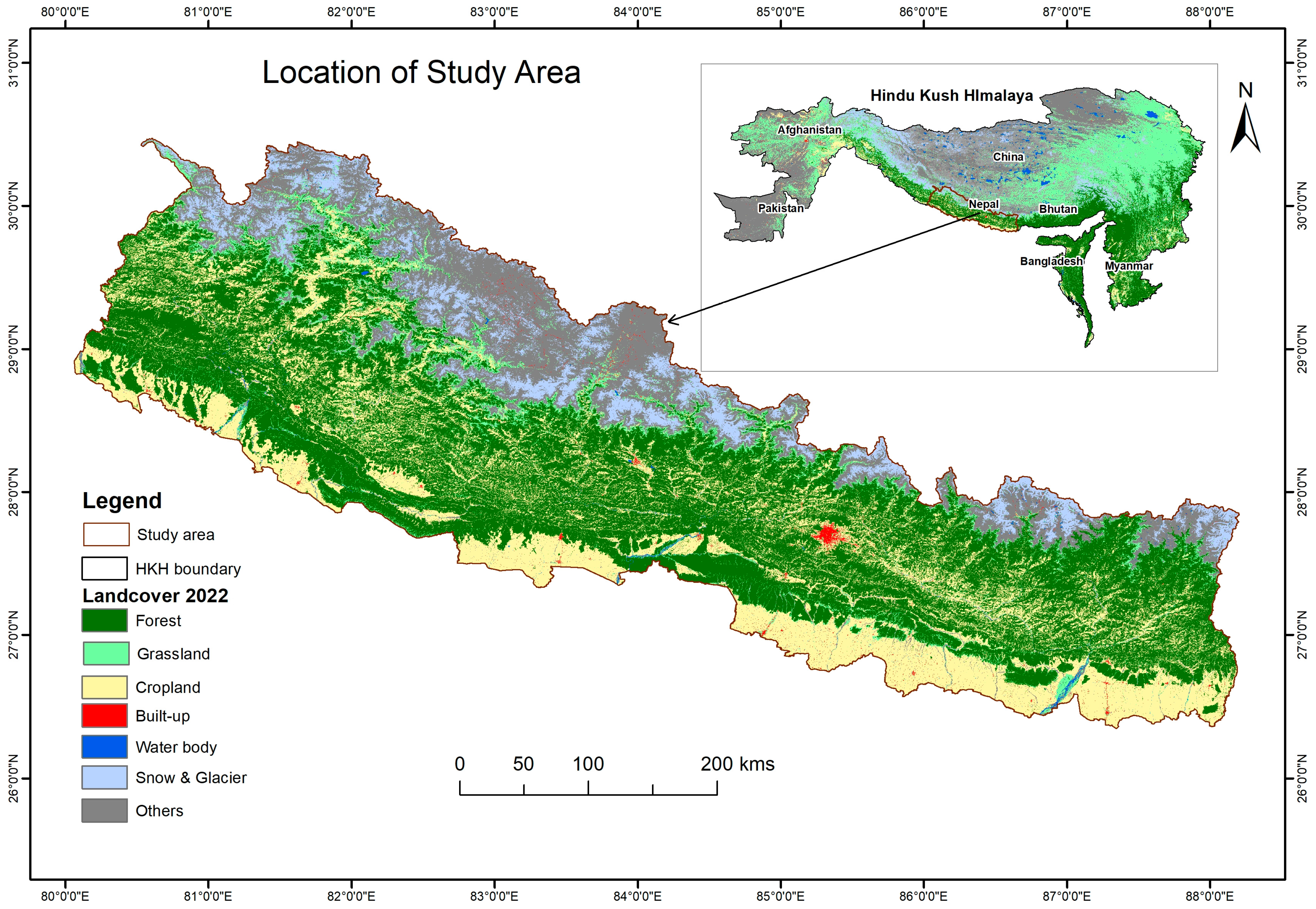


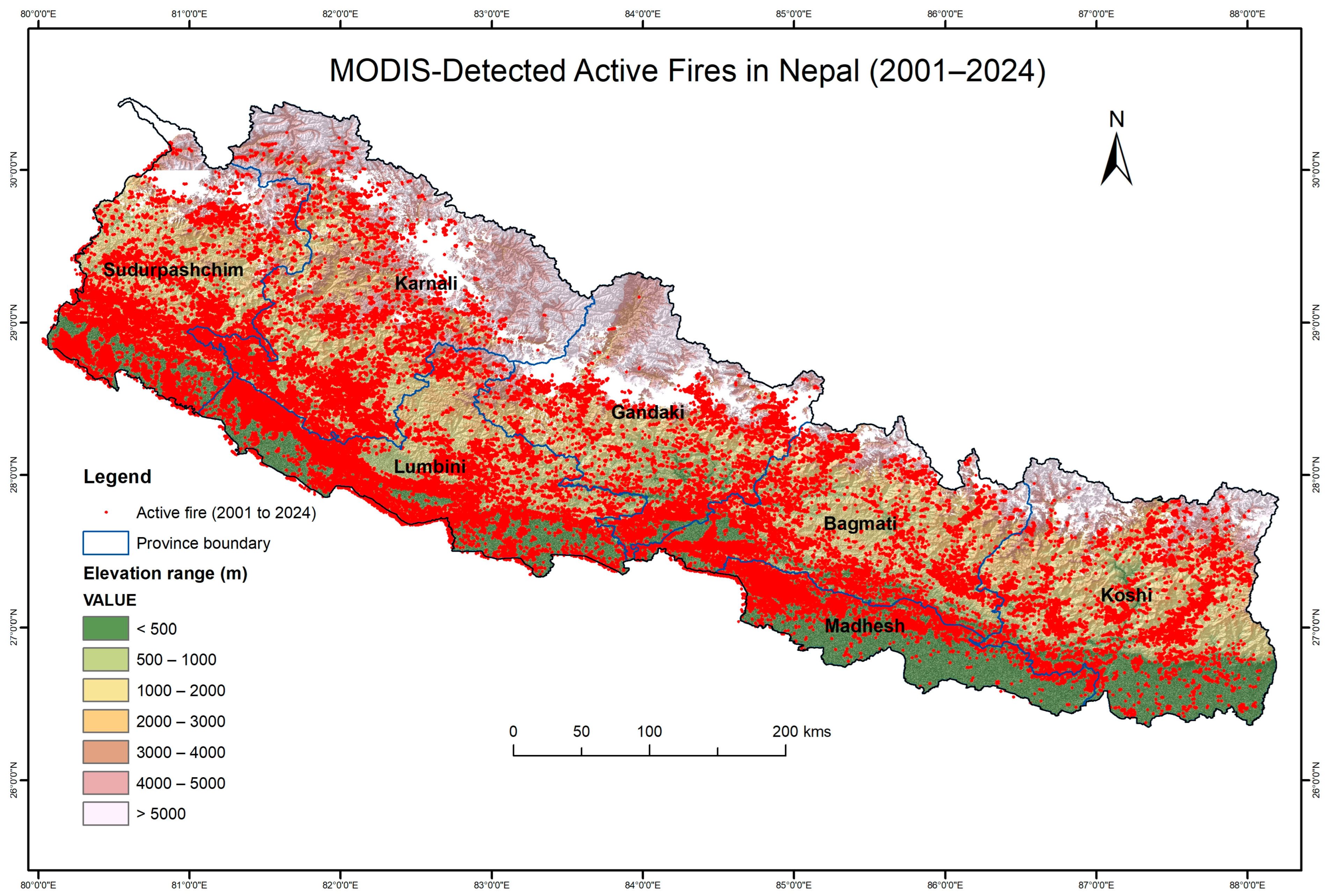

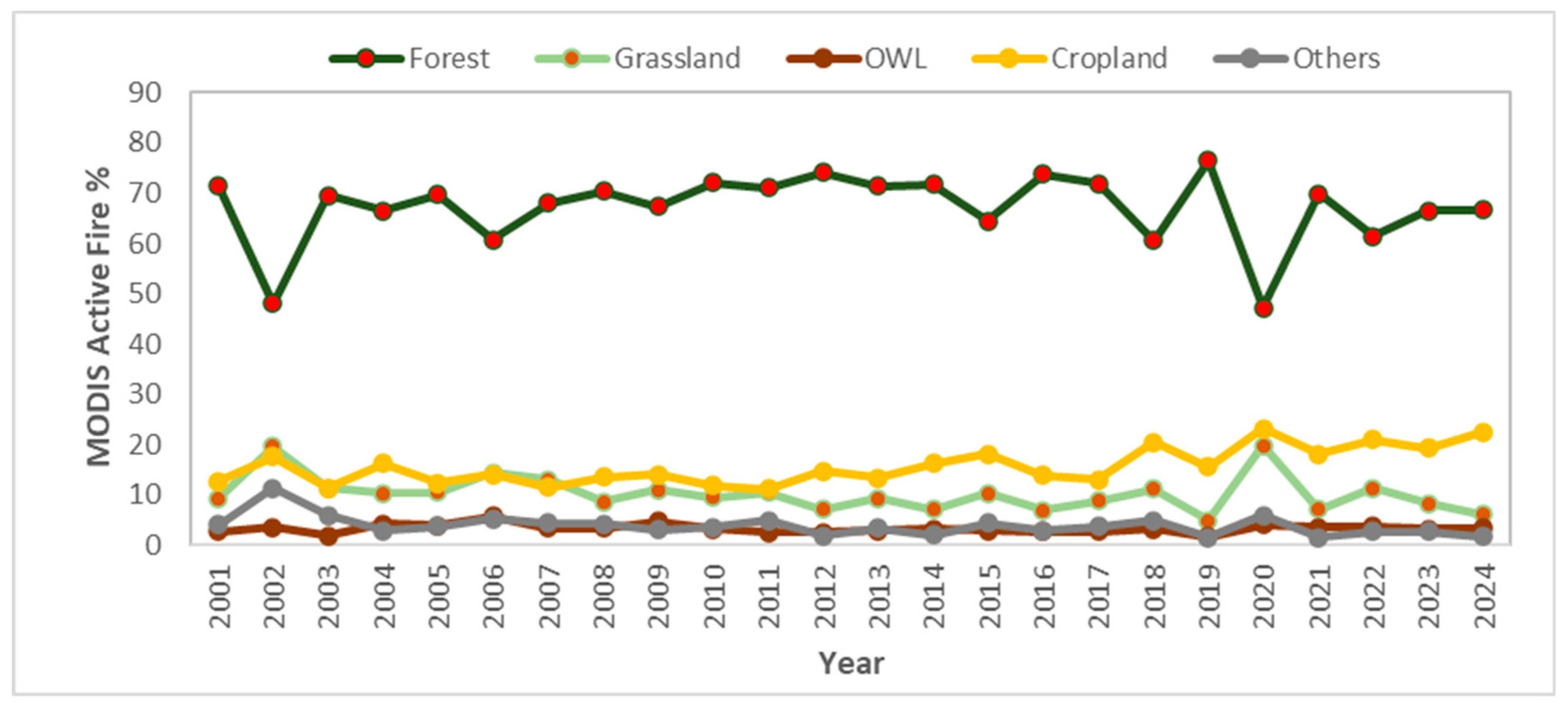

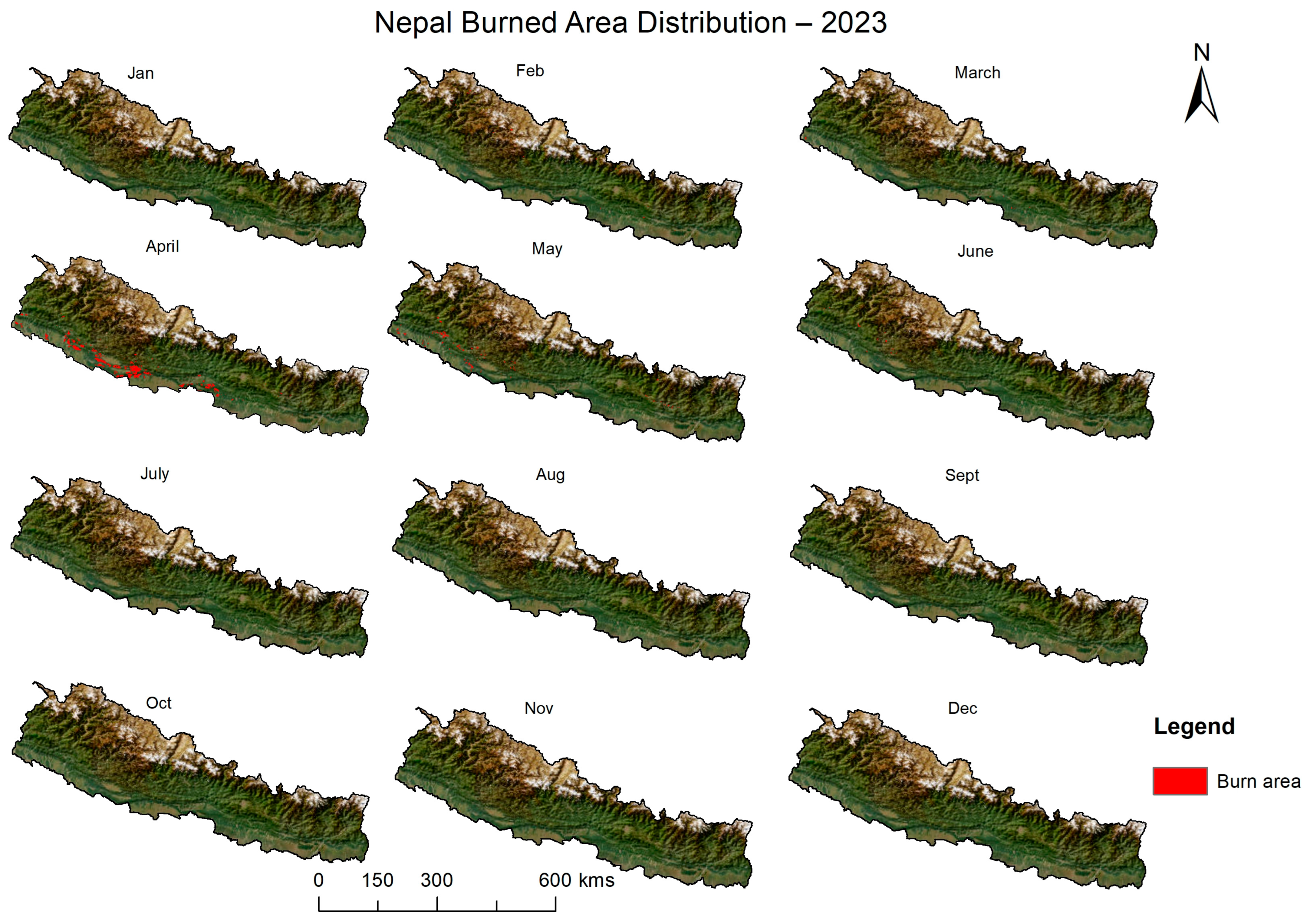




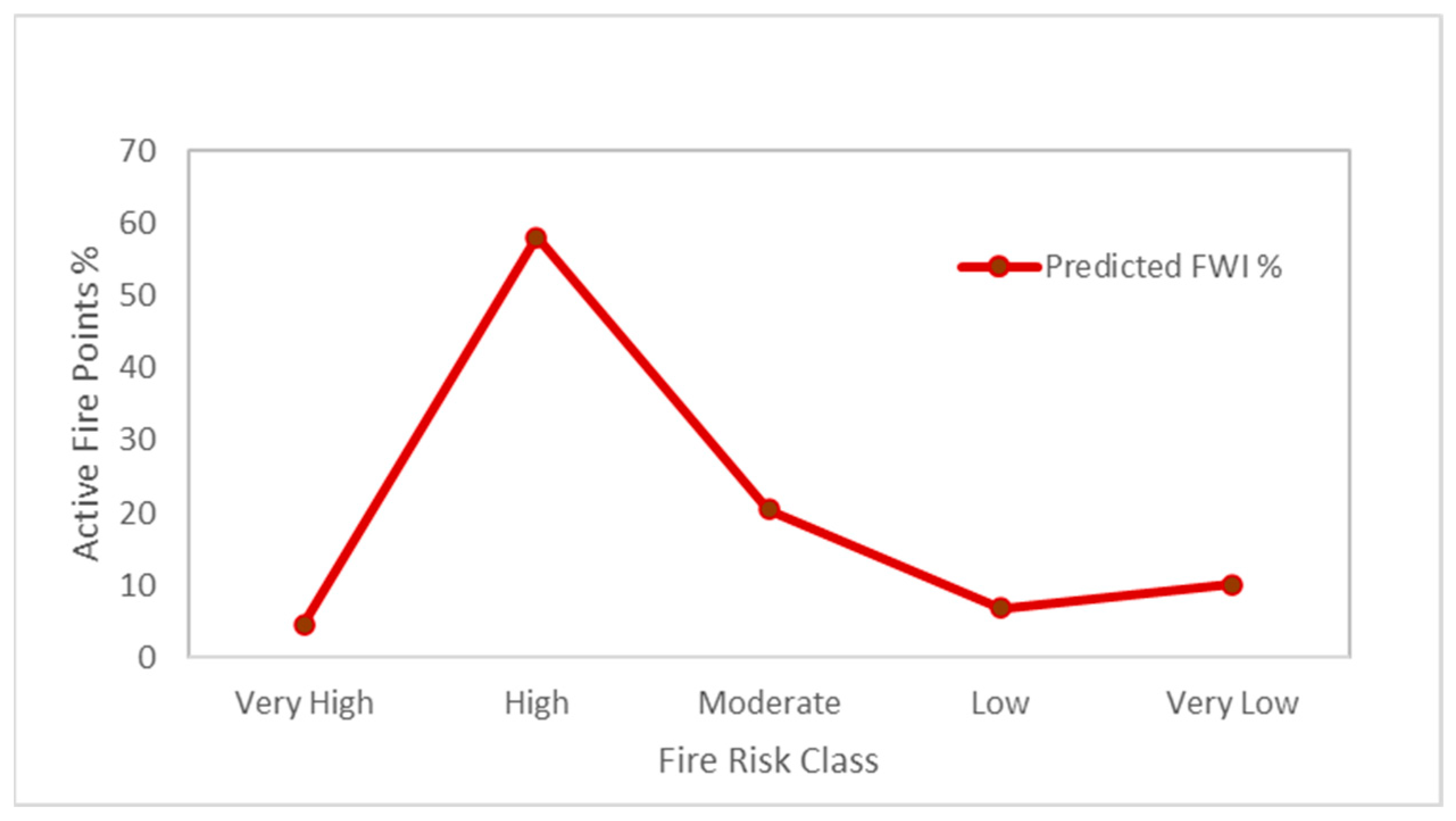
Disclaimer/Publisher’s Note: The statements, opinions and data contained in all publications are solely those of the individual author(s) and contributor(s) and not of MDPI and/or the editor(s). MDPI and/or the editor(s) disclaim responsibility for any injury to people or property resulting from any ideas, methods, instructions or products referred to in the content. |
© 2025 by the authors. Licensee MDPI, Basel, Switzerland. This article is an open access article distributed under the terms and conditions of the Creative Commons Attribution (CC BY) license (https://creativecommons.org/licenses/by/4.0/).
Share and Cite
Thapa, S.; Maraseni, T.; Dhonju, H.K.; Shakya, K.; Shakya, B.; Apan, A.; Banerjee, B. Predictive Assessment of Forest Fire Risk in the Hindu Kush Himalaya (HKH) Region Using HIWAT Data Integration. Remote Sens. 2025, 17, 2255. https://doi.org/10.3390/rs17132255
Thapa S, Maraseni T, Dhonju HK, Shakya K, Shakya B, Apan A, Banerjee B. Predictive Assessment of Forest Fire Risk in the Hindu Kush Himalaya (HKH) Region Using HIWAT Data Integration. Remote Sensing. 2025; 17(13):2255. https://doi.org/10.3390/rs17132255
Chicago/Turabian StyleThapa, Sunil, Tek Maraseni, Hari Krishna Dhonju, Kiran Shakya, Bikram Shakya, Armando Apan, and Bikram Banerjee. 2025. "Predictive Assessment of Forest Fire Risk in the Hindu Kush Himalaya (HKH) Region Using HIWAT Data Integration" Remote Sensing 17, no. 13: 2255. https://doi.org/10.3390/rs17132255
APA StyleThapa, S., Maraseni, T., Dhonju, H. K., Shakya, K., Shakya, B., Apan, A., & Banerjee, B. (2025). Predictive Assessment of Forest Fire Risk in the Hindu Kush Himalaya (HKH) Region Using HIWAT Data Integration. Remote Sensing, 17(13), 2255. https://doi.org/10.3390/rs17132255









